Matt_inthehills
Structural
Hi Guys and Gals,
I have a question regarding an ADU that I'm modeling. The client wants a breezeway, but does not want walls, or posts to support it. It will be connecting the ADU to the existing house.
Supporting the ADU side of the breezeway is easy. The walls will be new, and bearing the ridge, or beams down to the footings isn't an issue.
The trickier part is finding a simple solution to support the house side.
Would it be best to design the side beams that the rafters sit on large enough to support the span (12' clear from adu to house), and open up the walls of the house to add studs to bear down on. Then use a non structural ridge board to support the top. Or, is there a way to do this without opening the house walls up. Perhaps with a larger ridge beam to support the load, and have it bear on the existing roof, ideally on top of a truss, then smaller beams on the sides that could possible tie in to the subfascia board of the house?
Thanks!
Here's a picture for context...

I have a question regarding an ADU that I'm modeling. The client wants a breezeway, but does not want walls, or posts to support it. It will be connecting the ADU to the existing house.
Supporting the ADU side of the breezeway is easy. The walls will be new, and bearing the ridge, or beams down to the footings isn't an issue.
The trickier part is finding a simple solution to support the house side.
Would it be best to design the side beams that the rafters sit on large enough to support the span (12' clear from adu to house), and open up the walls of the house to add studs to bear down on. Then use a non structural ridge board to support the top. Or, is there a way to do this without opening the house walls up. Perhaps with a larger ridge beam to support the load, and have it bear on the existing roof, ideally on top of a truss, then smaller beams on the sides that could possible tie in to the subfascia board of the house?
Thanks!
Here's a picture for context...


